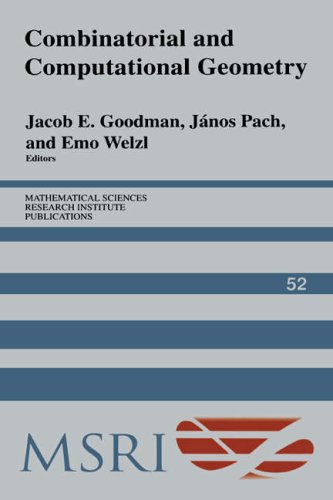
Combinatorial and Computational Geometry
by J. E. Goodman, J. Pach, E. Welzl
Publisher: Cambridge University Press 2007
ISBN/ASIN: 0521848628
ISBN-13: 9780521848626
Number of pages: 616
Description:
This volume includes surveys and research articles exploring geometric arrangements, polytopes, packing, covering, discrete convexity, geometric algorithms and their complexity, and the combinatorial complexity of geometric objects, particularly in low dimension. There are points of contact with many applied areas such as mathematical programming, visibility problems, kinetic data structures, and biochemistry, and with algebraic topology, geometric probability, real algebraic geometry, and combinatorics.
Download or read it online for free here:
Download link
(multiple PDF files)
Similar books
 The Fourth Dimension
The Fourth Dimensionby Charles Howard Hinton - S. Sonnenschein & Co.
C. H. Hinton discusses the subject of the higher dimensionality of space, his aim being to avoid mathematical subtleties and technicalities, and thus enable his argument to be followed by readers who are not sufficiently conversant with mathematics.
(5868 views)
 An Introduction to Geometry
An Introduction to Geometryby Wong Yan Loi - National University of Singapore
Contents: A Brief History of Greek Mathematics; Basic Results in Book I of the Elements; Triangles; Quadrilaterals; Concurrence; Collinearity; Circles; Using Coordinates; Inversive Geometry; Models and Basic Results of Hyperbolic Geometry.
(14544 views)
 Geometric Theorems and Arithmetic Functions
Geometric Theorems and Arithmetic Functionsby Jozsef Sandor - American Research Press
Contents: on Smarandache's Podaire theorem, Diophantine equation, the least common multiple of the first positive integers, limits related to prime numbers, a generalized bisector theorem, values of arithmetical functions and factorials, and more.
(18778 views)
 Categorical Geometry
Categorical Geometryby Zhaohua Luo
This is a book on the general theory of analytic categories. From the table of contents: Introduction; Analytic Categories; Analytic Topologies; Analytic Geometries; Coherent Analytic Categories; Coherent Analytic Geometries; and more.
(14734 views)